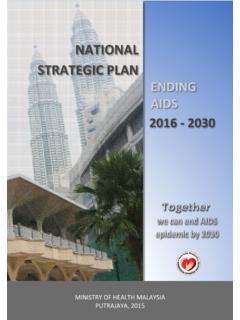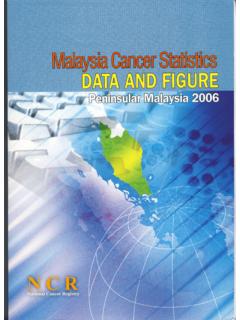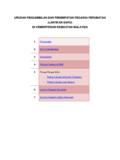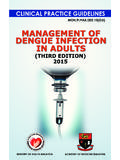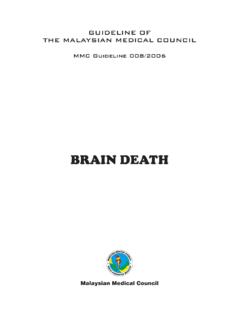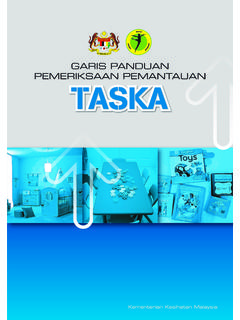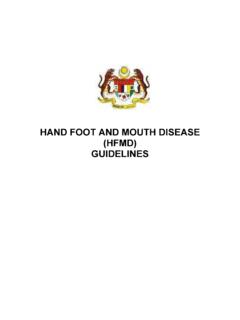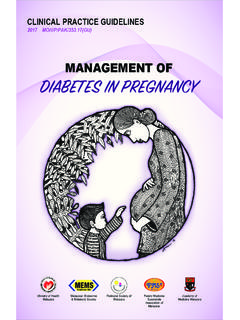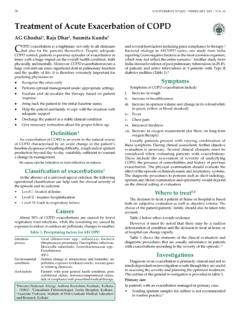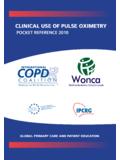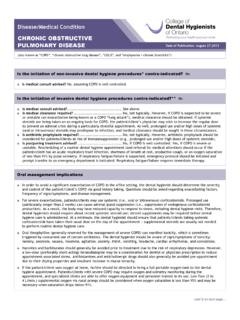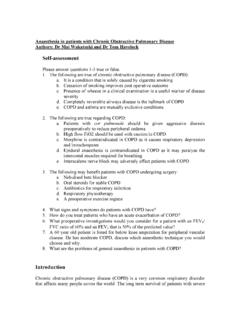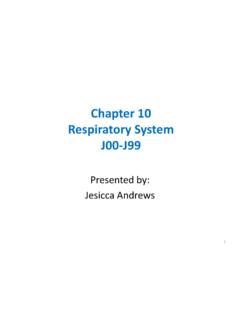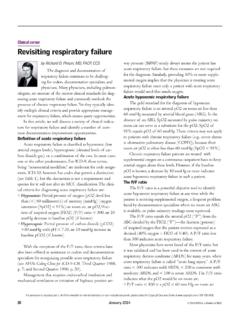Transcription of PREFACE - moh.gov.my
1 AbiPREFACEC hronic obstructive pulmonary disease ( copd ) is a common illness associated with major morbidity and high mortality throughout the world. It is the fourth leading cause of death in the United States1 and is projected to rank fifth by 2020 in terms of burden of disease worldwide, according to a study by the World Bank and World Health Yet copd is relatively unknown to the public and often ignored by health policy makers and government 1998, the Malaysian Thoracic Society with the support of the Academy of Medicine of Malaysia and Ministry of Health of Malaysia in their efforts to create awareness about the disease and improve patient care, initiated the publication of copd management guidelines to be used as a reference for medical The working group comprised 10 respiratory specialists who were working in government hospitals, teaching institutions and private medical facilities. The recommendations made were mainly based on the published literature available at the time after thorough assessment by the assigned member or members of the working group and discussion at several face-to-face meetings.
2 The evidence used for the recommendations was then graded according to its level of strength with some recommendations made based on the consensus agreement of members of the working group. Notwithstanding, the concept of evidence-based medicine was just emerging at that time. After more than a decade, with advancement of care made and with the publication of many important large-scale, randomised studies which added new dimension to the management of copd , the time had come for these guidelines to be reviewed and updated. An updated set of CPG will ensure that the recommendations for the management of copd in Malaysia are current. We would like to emphasise the importance of (1) early diagnosis through targeted spirometry and early intervention including smoking cessation even in mild copd ; (2) improving dyspnoea and activity limitation in stable copd using up-to-date evidence-based treatment algorithms; and (3) preventing and managing acute exacerbations, particularly in more severe sincerely hope this revised edition of the CPG for the Management of copd will be fully utilised by all relevant healthcare professionals and will benefit patients suffering from copd .
3 I would like to express my heartfelt gratitude to everyone who was involved in the development of these guidelines and especially to the working group members for their enthusiasm, relentless effort and immense Dr. Liam Chong-Kin Chairman copd CPG Working Group References:1. National Heart, Lung, And Blood Institute. Morbidity And Mortality Chartbook On Cardiovascular, Lung And Blood Diseases. Bethesda, Maryland: Us Department Of Health And Human Services, Public Health Service, National Institute Of Health. Accessed At: ; Lopez Ad,Shibuya K, Rao C, Et Al. chronic obstructive pulmonary disease : Current burden and future projections. Eur Respir J 2006; 27 Guidelines In The Management Of chronic obstructive pulmonary disease -A Consensus Statement Of The Ministry Of Health Of Malaysia, Academy Of Medicine Of Malaysia And Malaysian Thoracic Society. Med J Malaysia 1999; 54 DEVELOPMENT AND OBJECTIVESG uidelines DevelopmentRespiratory physicians working in government hospitals, academic institutions and private medical facilities; an emergency medicine physician and primary care physicians from a government health clinic, an academic institution and private general practice were invited to be members of the guidelines development working group.
4 The previous edition of the CPG on the Management of copd (1998) was used as the basis for the development of this present set of guidelines. Members of the working group were divided into smaller groups comprising 2 to 5 members who were assigned to prepare documents on the following sections: (1) definition, classification of severity and mechanism of copd ; (2) burden of copd ; (3) risk factors; (4) assessment and monitoring of disease ; (5) reducing risk factors; (6) managing stable copd - pharmacological treatments; (7) managing stable copd - non-pharmacological treatments; (8) managing exacerbations; and (9) translating guidelines recommendations to the context of primary care. Members responsible for each section were tasked to ensure that the relevant literature was adequately searched, retrieved, critically appraised and accurately presented. Literature search was carried out at electronic databases which included PUBMED, Medline and Cochrane Database of Systemic Reviews.
5 The full text of reference articles quoted in these guidelines was carefully studied. In addition, the reference lists of relevant articles retrieved were searched to identify other studies. Other guidelines on the management of copd that were referred to included the Guidelines of the Global Initiative for chronic obstructive Lung disease (GOLD) global strategy for the diagnosis, management and prevention of chronic obstructive pulmonary disease (2008) and the Canadian Thoracic Society recommendations for management of chronic obstructive pulmonary disease (2007). Each section leader presented his/her section of the proposed guidelines at several meetings where all members of the working group met and participated in the discussion. The final draft of these guidelines inclusive of recommendations was the result of agreement by the majority, if not all, members of the working group at such meetings as well as through e-mail discussions in between the meetings.
6 Throughout the development of these guidelines, a total of six meetings were held from 10 January 2009. In situations where the evidence was insufficient or lacking, the recommendations made were by consensus of the working these guidelines, statements are supported by evidence which is graded using the United States/Canadian Preventive Services Task Force Level of Evidence scale with the level of evidence indicated in parentheses after the relevant statement, while the grading of recommendations was based on modified Scottish Intercollegiate Guidelines Network s (SIGN) Grade of Recommendations which is also shown in parentheses. The draft guidelines were sent for external review. The draft guidelines were also posted on the Ministry of Health Malaysia website for comments and feedback. These guidelines were presented to the Technical Advisory Committee for Clinical Practice Guidelines and the Health Technology Assessment and Clinical Practice Guidelines Council, Ministry of Health Malaysia for review and main objective of these guidelines is to provide up-to-date evidence-based recommendations to assist health care providers in the identification, diagnosis and optimal management of people with copd .
7 Clinical QuestionsThe clinical questions of these guidelines are:1. How can copd be prevented?2. How is copd diagnosed?3. How can people with copd be optimally managed?Target PopulationThese guidelines are applicable to all adults with copd . Target Groups/UsersThese guidelines are intended for all health care professionals involved in managing patients with copd who include: respiratory physicians, general physicians, geriatricians, family medicine specialists, emergency medicine physicians, medical officers, general practitioners, assistant medical officers, pharmacists, respiratory nurse educators, nurses, physiotherapists and public health INDICATORS FOR QUALITY MANAGEMENTP roportion of people with copd treated for acute exacerbation (with antibiotics and/or systemic corticosteroids and/or requiring hospitalisation)Numerator : Number of episodes of acute exacerbation treated in one year#Denominator : Total number of patients with copd on treatment in one year(#It is necessary to distinguish patients with moderate stable copd from those with severe or very severe stable copd )The optimum achievable standard: For patients with Moderate copd .
8 1 exacerbation per patient per year Severe or very severe copd : exacerbations per patient per yearThese standards are arrived at based on the results of several recent large randomised controlled trials. In the INSPIRE study involving patients with severe and very severe copd (FEV1 < 50% predicted), the exacerbations rates were per year in patients treated with salmeterol/fluticasone combination and per year in patients on (Level 1) In the TORCH study involving patients with moderate to very severe copd (FEV1 < 60% predicted), treatment with salmeterol, fluticasone and salmeterol/fluticasone combination was associated with exacerbation rates of , and , respectively compared to in patients on (Level 1) In the UPLIFT study involving patients with moderate to very severe copd (FEV1 70% predicted) already on a regular b2-agonist with or without inhaled corticosteroids, treatment with tiotropium or placebo was associated with exacerbation rates of and per patient-year, (Level 1)REFERENCES:1.
9 Wedzicha JA, Calverley PM, Seemungal TA, et al. The prevention of chronic obstructive pulmonary disease exacerbations by salmeterol/fluticasone propionate or tiotropium bromide. Am J Respir Crit Care Med 2008; 177 Calverley PMA, Anderson JA, Celli B, et al. Salmeterol and fluticasone propionate and survival in chronic obstructive pulmonary disease . N Engl J Med 2007; 356 Tashkin DP, Celli B, Senn S, et al. A 4-year trial of tiotropium in chronic obstructive pulmonary disease . N Engl J Med 2008; 359 OF CONTENTS PREFACE iGUIDELINES DEVELOPMENT AND OBJECTIVES iiCLINICAL INDICATORS FOR QUALITY MANAGEMENT iiiCLINICAL PRACTICE GUIDELINES WORKING GROUP viEXTERNAL REVIEWERS viiSECTION 1 DEFINITION, CLASSIFICATION OF SEVERITY AND PATHOPHYSIOLOGY 1 Definition 1 Airflow Limitation in copd 1 Spirometric Classification of copd Severity 1 Assessment of copd Severity 3 Pathology, Pathogenesis and Pathophysiology 5 SECTION 2 copd : EPIDEMIOLOGY AND disease BURDEN 6 SECTION 3 RISK FACTORS 8 Introduction 8 Genes 8 Exposure to Particles 8 Lung Growth and Development 9 Oxidative Stress 9 Gender 9 Infection 9 Socioeconomic Status 10 SECTION 4 ASSESSMENT AND MONITORING 11 Initial Diagnosis 11 Assessment of Symptoms 11 Medical History 11 Physical Examination 12 Measurement of Lung Function 12 Bronchodilator Reversibility Testing 12 Assessment of copd Severity 12 Additional Investigations 12 Differential Diagnosis 13 Ongoing Monitoring and Assessment 14 SECTION 5 REDUCING RISK FACTORS 16 Introduction 16 Smoking Prevention 16 Smoking Cessation 16 Five Step Programme for Intervention (5A) 17 Counselling 18 Pharmacotherapy 18 Occupational Exposure 18 Indoor and Outdoor Air Pollution 18 Steps for Health Care Providers/Patients 19ivvSECTION 6 MANAGING STABLE copd .
10 EDUCATION AND PHARMACOLOGICAL TREATMENTS 20 Objectives of Managing Stable copd 20 Patient Education 20 Influenza Vaccination 21 Pneumococcal Vaccination 21 Treatment Strategy: Pharmacological and Non-pharmacological Treatments 21 SECTION 7 MANAGING STABLE copd : NON-PHARMACOLOGICAL TREATMENTS 28 pulmonary Rehabilitation in copd 28 Domiciliary Oxygen Therapy for copd 29 Nutrition in copd 30 Lung Volume Reduction for copd 30 Lung Transplantation 31 copd and Surgery 31 SECTION 8 MANAGING EXACERBATIONS OF copd 33 Introduction 33 Definition of Acute Exacerbation of copd 33 Morbidity and Mortality Associated with Acute Exacerbations of copd 33 Causes of Acute Exacerbations of copd 33 Diagnosis and Assessment of Severity 33 Differential Diagnoses 35 Managing Acute Exacerbations of copd 35 Home Management 36 Hospital Management 36 Management of Severe but Not Life Threatening Exacerbations of copd in the Emergency Department or the Hospital 42 Non-invasive Ventilation 43 Invasive Mechanical Ventilation 43 Hospital Discharge 44 Follow Up 44 SECTION 9 TRANSLATING GUIDELINES RECOMMENDATIONS TO THE CONTEXT OF PRIMARY CARE 45 Introduction 45 Early Diagnosis 45

